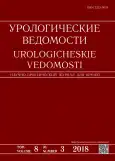Prognostic significance of the evaluation of expression of the gene PCA3 in urine in patients with localized prostate cancer and histomorphological changes in the peritumoral zone
- Authors: Bova P.S.1
-
Affiliations:
- Rostov State Scientific Research Institute of Oncology of the Ministry of Health of Russia
- Issue: Vol 8, No 3 (2018)
- Pages: 11-19
- Section: Articles
- URL: https://journals.rcsi.science/uroved/article/view/10458
- DOI: https://doi.org/10.17816/uroved8311-19
- ID: 10458
Cite item
Abstract
Aim. To determine the prognostic significance PCA3 gene expression in urine sediment and exosomes in patients with localized prostate cancer (PC) and associated histologic changes in the peritumoral zone as a predictor of biochemical recurrence after radical prostatectomy (RPE).
Materials and methods. Of 148 patients with localized PC, 96 (65%) had high-grade prostatic intraepithelial neoplasia (PIN-2) in the peritumoral zone. The other 52 (35%) had no pathologic tissue of the peritumoral zone. PDA3 expression in urine sediment and exosomes was determined with real-time PCR with respect to the reference gene KLK3.
Results. The PCA3 gene expression level in urine exosomes in patients with PIN-2 in the prostatic peritumoral zone and synchronous pancreatic adenocarcinoma was higher among patients with subsequent disease recurrence. Increased PCA3 gene expression in the urine sediment was also predictive of the risk of recurrence of a prostatic tumor with PIN-2 in the peritumoral zone, although to a lesser degree than the results with urine exosomes. When the ∆Ct РСА3-KLK3 was ≥1,86 in the urine sediment, biochemical recurrence of PC and PIN-2 developed more frequently in the peritumoral zone (84% versus 51%, p = 0,013).
Conclusions. Increased PCA3 gene expression in urine sediment and exosomes is a predictor of increased risk of biochemical recurrence after RPE in patients with localized PC and PIN-2 in the peritumoral zone.
Full Text
##article.viewOnOriginalSite##About the authors
Philip S. Bova
Rostov State Scientific Research Institute of Oncology of the Ministry of Health of Russia
Author for correspondence.
Email: alald@inbox.ru
Candidate of Medical Sciences, Doctorant
Russian Federation, Rostov-on-DonReferences
- Толкач Ю.В., Рева С.А., Носов А.К., и др. Клиническая значимость генетической характеризации рака предстательной железы: обзор литературы // Онкоурология. - 2015. - № 2. - С. 99-106. [Tolkach YuV, Reva SA, Nosov AK, et al. Clinical Significance of Genetic Characterization of Prostate Cancer: A Review of Literature. Onkourologiya. 2015;(2):99-106. (In Russ.)]. doi: 10.17650/1726-9776-2015-11-2-99-106.
- Сергеева Н.С., Скачкова Т.Е., Маршутина Н.В., и др. Клиническая значимость ПСА-ассоциированных тестов в диагностике и стадировании рака предстательной железы // Онкология. - 2018. - № 1. - С. 55-67. [Sergeeva NS, Skachkova TE, Marshutina NV, et al. Clinical significance of PSA-associated tests in the diagnosis and staging of prostate cancer. Onkologija. 2018;(1):55-67. (In Russ.)]. doi: 10.17116/onkolog20187155-67.
- Шкурников М.Ю., Алексеев Б.Я. Ассоциация экспрессии генов рецепторов фактора роста тромбоцитов альфа и бета (PDGFRA и PDGFRB) с биохимическим рецидивом рака предстательной железы после радикальной простатэктомии // Онкоурология. - 2017. - Т. 13. - № 4. - С. 45-50. [Shkurnikov MYu, Alekseev BYa. Association of gene expression of platelet-alpha-beta-beta receptor (PDGFRA and PDGFRB) receptors with biochemical recurrence of prostate cancer after radical prostatectomy. Onkourologiya. 2017;13(4):45-50. (In Russ.)]. doi: 10.17650/1726-9776-2017-13-4-45-50.
- Михайленко Д.С., Новиков А.А., Григорьева М.В., и др. Сравнение экспрессии гена РСА3 в осадках и экзосомах мочи при раке предстательной железы // Онкоурология. - 2017. - Т. 13. - № 3. - С. 54-60. [Mihajlenko DS, Novikov AA, Grigor’eva MV, et al. Comparison of the expression of the PCA3 gene in precipitates and urine exosomes in prostate cancer. Onkourologiya. 2017;13(3):54-60. (In Russ.)]. doi: 10.17650/1726-9776-2017-13-3-54-60.
- Коган М.И., Чибичян М.Б., Водолажский Д.И. Изменение экспрессии генетических локусов в мононуклеарной фракции периферической крови больных раком предстательной железы // Клиническая онкология. - 2012. - № 5. - С. 59-60. [Kogan MI, Chibichjan MB, Vodolazhskij DI. Change in the expression of genetic loci in the mononuclear fraction of peripheral blood of patients with prostate cancer. Klinicheskaja onkologija. 2012;(5):59-60. (In Russ.)]
- Аполихин О.И., Сивков А.В., Ефремов Г.Д., и др. РСА3 и TMPRSS2: ERG в диагностике рака предстательной железы: первый опыт применения комбинации маркеров в России // Экспериментальная клиническая урология. - 2015. - № 2. - С. 30-35. [Apolikhin OI, Sivkov AV, Efremov GD, et al. The first Russian experience of using PCA3 and TMPRSS2-ERG for prostate cancer diagnosis. Experimental’naya klinicheskaya urologiya. 2015;(2):30-5. (In Russ.)]
- Mc Neal JE. Origin and development of carcinoma in the prostate. Cancer. 1969;23:24-34.
- Юрмазов З.А., Васильев Н.В. Клинические и морфологические особенности рака предстательной железы в сочетании с ПИН // Сибирский онкологический журнал. - 2010. - Приложение № 1. - С. 118. [Jurmazov ZA, Vasil’ev NV. Clinical and morphological features of prostate cancer in combination with PIN. Sibirskij onkologicheskij zhurnal. 2010;(Suppl. 1):118. (In Russ.)]
- Loeb S, Bjurlin MA, Nicholson J, et al. Overdiagnosis and overtreatment of prostate cancer. Eur Urol. 2014;65(6):1046-1055. doi: 10.1016/j.eururo.2013.12.062.
- Adhyam M, Gupta AK. A review on the clinical utility of PSA in cancer prostate. Indian J Surg Oncol. 2012;3(2):120-129. doi: 10.1007/s13193-012-0142-6.
- Valadi H, Ekstrom K, Bossios A, et al. Exosome-mediated transfer of mRNAs and microRNAs is a novel mechanism of genetic exchange between cells. Nat Cell Biol. 2007;9:654-659. doi: 10.1038/ ncb1596.
- Молекулярный канцерогенез / Под ред. М.А. Красильникова, И.Б. Зборовской. - М.: АБВ-пресс, 2016. - 418 c. [Molecular carcinogenesis. Ed by M.A. Krasil’nikov, I.B. Zborovskaya. Moscow: ABV-press; 2016. 418 p. (In Russ.)]
- Louie KS, Seigneurin A, Cathcart P, Sasieni P. Do prostate cancer risk models improve the predictive accuracy of PSA screening? A meta-analysis. Ann Oncol. 2015;26(5):848-64. doi: 10.1093/annonc/mdu525.
Supplementary files







